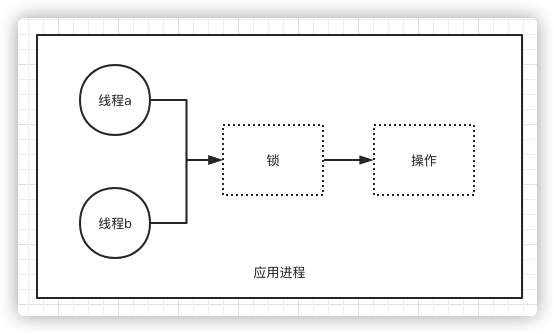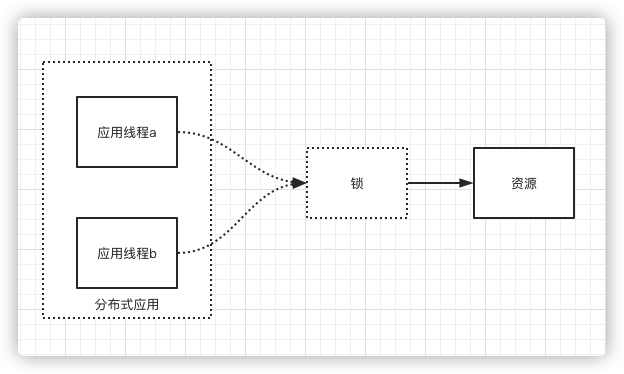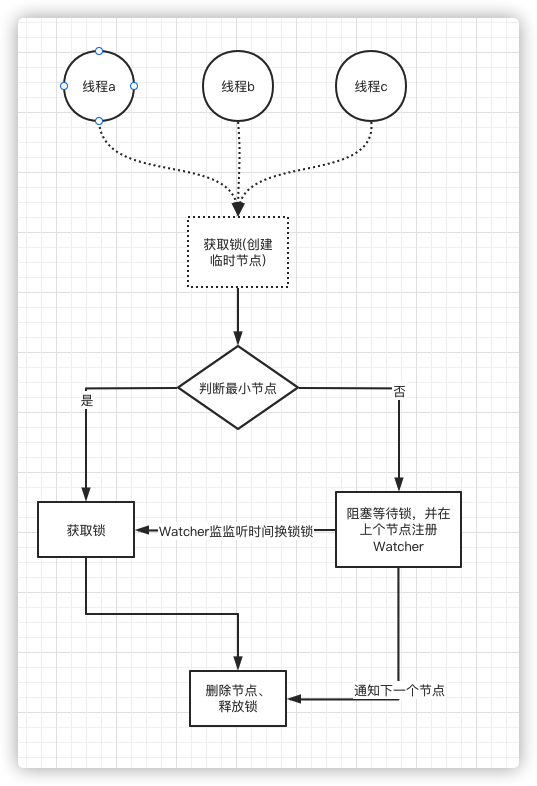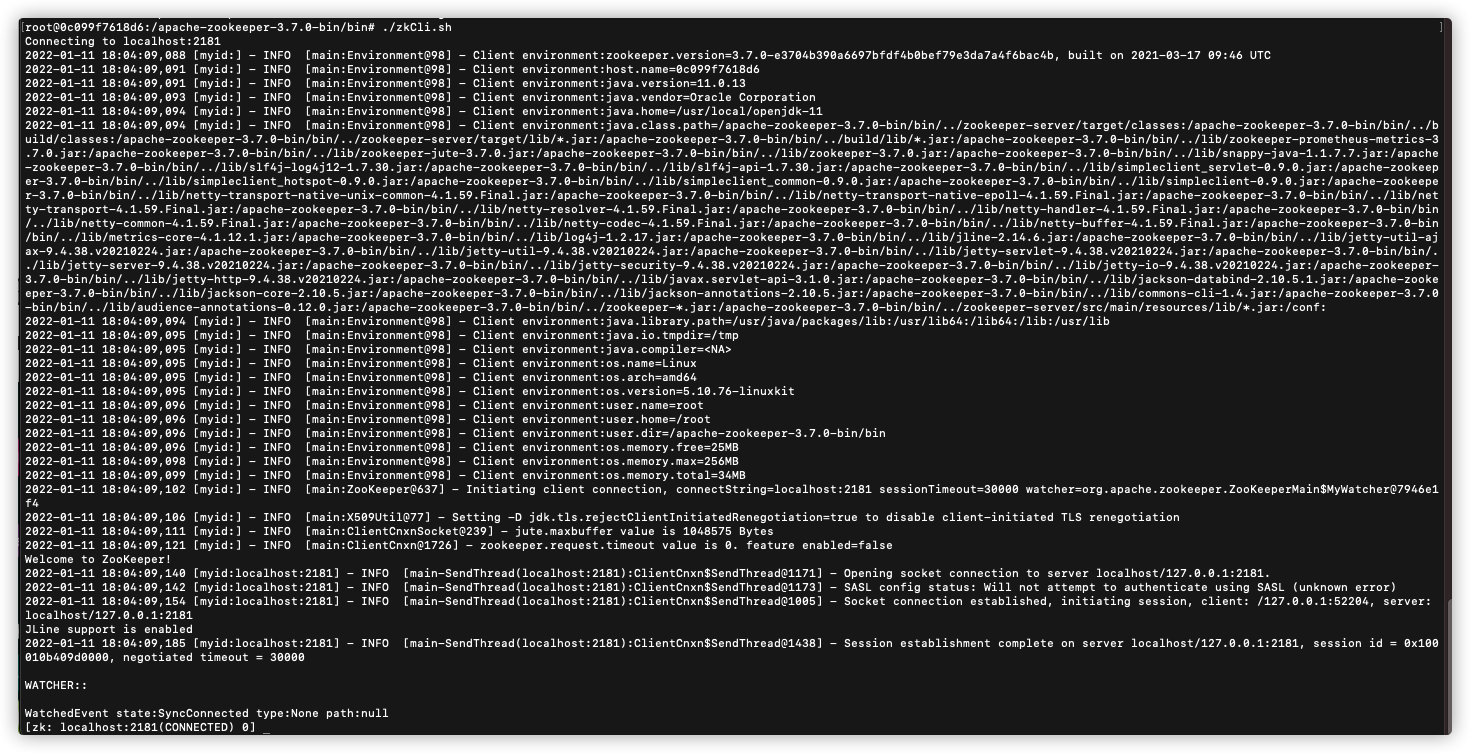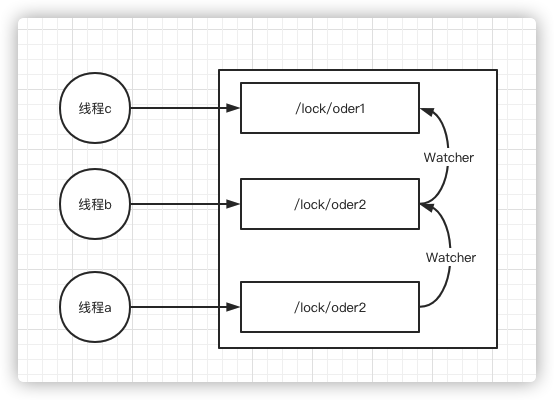分布式锁是控制分布式系统之间同步访问共享资源的一种方式。是为了解决分布式系统中,不同的系统或是同一个系统的不同主机共享同一个资源的问题,它通常会采用互斥来保证程序的一致性。
锁
锁是一种常用的并发控制机制,用于保证一项资源在任何时候只能被一个线程使用,如果其他线程也要使用同样的资源,必须排队等待上一个线程使用完。
分布式锁
上面说的锁指的是程序级别的锁,例如 Java 语言中的 synchronized 和 ReentrantLock 在单应用中使用不会有任何问题,但如果放到分布式环境下就要使用分布式锁。
实现分布式锁方案
- 基于 MySQL 的悲观锁来实现分布式锁,性能不太好。容易写bug造成Mysql死锁问题。
- 基于数据库实现分布式锁比较简单,绝招在于创建一张锁表,为申请者在锁表里建立一条记录,记录建立成功则获得锁,消除记录则释放锁。
- 单点故障问题。一旦数据库不可用,会导致整个系统崩溃。
- 死锁问题。数据库锁没有失效时间,未获得锁的进程只能一直等待已获得锁的进程主动释放锁。倘若已获得共享资源访问权限的进程突然挂掉、或者解锁操作失败,使得锁记录一直存在数据库中,无法被删除,而其他进程也无法获得锁,从而产生死锁现象。
- 基于 Redis 实现分布式锁,目前广泛使用的方案。
- 当多个进程频繁去访问 Redis 时,Redis 可能成为瓶颈。关键Redis并不是和做分布式锁(比较极端的场景下)
- 反复尝试会增加通信成本和性能开销,需要指定重试的次数。如果每次都是众多进程进行竞争的话,有可能会导致有些进程永远获取不到锁。
- 可以集群部署,可以避免单点故障。
- 基于 ZooKeeper 实现分布式锁,利用 ZooKeeper 顺序临时节点来实现。
- ZooKeeper 基于树形数据存储结构实现分布式锁,来解决多个进程同时访问同一临界资源时,数据的一致性问题。
- 持久节点(PERSISTENT)。这是默认的节点类型,一直存在于 ZooKeeper 中。
- 持久顺序节点(PERSISTENT_SEQUENTIAL)。在创建节点时,ZooKeeper 根据节点创建的时间顺序对节点进行编号命名。
- 临时节点(EPHEMERAL)。当客户端与 Zookeeper 连接时临时创建的节点。与持久节点不同,当客户端与 ZooKeeper 断开连接后,该进程创建的临时节点就会被删除。
- 临时顺序节点(EPHEMERAL_SEQUENTIAL)。就是按时间顺序编号的临时节点。
- zookeeper在分布式环境下能保证互斥,具备锁失效机制。防止死锁即便出现持有锁崩溃或者锁失败的情况也能被动解锁。保证后续的线程可以获得锁。并且可以多次访问临界资源。有高可用获得锁和释放锁的功能,性能并不是很差。
- 羊群效应,就是在整个 ZooKeeper 分布式锁的竞争过程中,大量的进程都想要获得锁去使用共享资源。每个进程都有自己的“Watcher”来通知节点消息,都会获取整个子节点列表,使得信息冗余,资源浪费。当共享资源被解锁后,Zookeeper 会通知所有监听的进程,这些进程都会尝试争取锁,但最终只有一个进程获得锁,使得其他进程产生了大量的不必要的请求,造成了巨大的通信开销,很有可能导致网络阻塞、系统性能下降。
- 在与该方法对应的持久节点的目录下,为每个进程创建一个临时顺序节点。
- 每个进程获取所有临时节点列表,对比自己的编号是否最小,若最小,则获得锁。
- 若本进程对应的临时节点编号不是最小的,则注册 Watcher,监听自己的上一个临时顺序节点,当监听到该节点释放锁后,获取锁。
- 基于etcd分布式锁实现
- 分别对这三种实现方式进行性能压测,可以发现在同样的服务器配置下,Redis 的性能是最好的,Zookeeper 次之,数据库最差。从实现方式和可靠性来说,Zookeeper 的实现方式简单,且基于分布式集群,可以避免单点问题,具有比较高的可靠性。因此,在对业务性能要求不是特别高的场景中,建议使用 Zookeeper 实现的分布式锁。
部署方案
- 单机
- 简单,但是不能保证高可用,一旦出现单点故障就gg了。
- 集群
- 在Redis场景下有大名鼎鼎的红锁(RedLock)
- 红锁的核心逻辑是,部署集群的情况下,比如5个master。加锁的时候挨个加锁。当满足(5/2+1)=3 的时候就表示加锁成功,也就是半数成功则算成功。释放锁也是类似的操作。但是也带来了通信成本。仍需要二次检查锁的完整性。
- 单点故障时,我们第一时间想到的就是搞几个 Slave 从节点做备份,Redis 里很好地支持了哨兵(Sentinel)模式,自动主从切换。锁写到Master后,还没同步到Slave呢,Master挂了Slave选举成了Master,但是Slave里没有锁,其他线程再次能上锁了。不安全。
- 如果非要用Redis方案来做锁,在保证高可用的情况下可以通过二次检查的逻辑防止锁故障。
- Redis集群只是做了 slot 分片,锁还是只写到一个 Master 上,所以它和哨兵(Sentinel)模式会面临同样的问题。
- Zookeeper提供了协调分布式应用的基本服务,它向外部应用暴露一组通用服务——分布式同步(Distributed Synchronization)
- Zookeeper本身就是一个分布式程序(只要有半数以上节点存活,zk就能正常服务)
- 如果是钱的业务,建议使用zookeeper。
- ZooKeeper实现分布式锁的核心原理是临时节点,更确切的说法是临时顺序节点。
- ZooKeeper的节点是通过session心跳来续期的,比如客户端1创建了一个节点, 那么客户端1会和ZooKeeper服务器创建一个Session,通过这个Session的心跳来维持连接。如果ZooKeeper服务器长时间没收到这个Session的心跳,就认为这个Session过期了,也会把对应的节点删除。临时节点类型的最大特性是:当客户端宕机后,临时节点会随之消亡。
- 在Redis场景下有大名鼎鼎的红锁(RedLock)
分布式锁的条件
可以提供分布式部署应用集群中,同一个方法只能在某一个应用的线程执行。
该锁需要包含一下特性:分布式互斥、重入锁、锁续期、阻塞锁、公平锁、良好的加锁和释放锁性能。
分布式使用场景
- 保证接口的幂等性,防止冲突提交数据。
- 防止重复消费,比如推送消息或者发送邮件。保证合理的执行次数。
- 防止分布式场景缓存击穿,比如秒杀活动的超卖情况。
分布式锁
Mysql实现分布式锁
单实例
演示代码
- 表结构,简单演示效果,表字段可以根据实际情况设计。这里需要注意如果要使用可重入,需要增加版本字段。
1 | -- 创建数据库 |
- 通过唯一约束判断锁是否生成。
1 | SELECT * FROM distributed_lock WHERE lock_id = ? LOCK IN SHARE MODE; |
- 加锁方式
1 | INSERT INTO `distributed_lock`(`lock_id`, `lock_value`) VALUES (?, ?) |
- 加锁代码
1 |
|
Redis实现分布式锁
单节点
在只存在master节点的情况下
- 通过
SET key value [EX seconds | PX milliseconds] [NX]来创建锁
1 | 127.0.0.1:6379> set lock true ex 30 nx |
- ex 是用来设置超时时间的,而 nx 是 not exists 的意思,用来判断键是否存在。如果返回的结果为“OK”则表示创建锁成功,否则表示此锁有人在使用。
- 防止锁被删除
- 防止锁过期,业务执行时间太长了。如果锁的时间很短。可能出现锁失效,建议将锁的过期时间设置长点,防止业务没执行完成锁消失后,被其它线程获取该锁。
通过给vaule设置一个唯一的值,在删除锁的时候判断是否当前业务程序操作。
- KEYS[1] 加锁单key
- ARGV[1] unique_value 防止被其它客户端非法删除
1 | if redis.call('get', KEYS[1]) == ARGV[1] |
- 执行语法
- 这种方式需要每次都传入 Lua 脚本字符串,不仅浪费网络开销,同时 Redis 需要每次重新编译 Lua 脚本,对于我们追求性能极限的系统来说,不是很完美。
1 | EVAL script numkeys key [key ...] arg [arg ...] |
- 另一种方式
- 其语法与 EVAL 类似,不同的是这里传入的不是脚本字符串,而是一个加密串 sha1。
1 | EVALSHA sha1 numkeys key [key ...] arg [arg ...] |
- SCRIPT LOAD
- 通过预加载命令,将 Lua 脚本先存储在 Redis 中,并返回一个 sha1,下次要执行对应脚本时,只需要传入 sha1 即可执行对应的脚本。这完美地解决了 EVAL 命令存在的弊端,所以我们这里也是基于 EVALSHA 方式来实现的。
1 | SCRIPT LOAD script |
演示代码
- 工具代码
1 |
|
- 测试代码
1 |
|
- Console
1 | [pool-2-thread-7] tryLock success 8e19a035-b610-4e68-a385-c133a1975fa8 8e19a035-b610-4e68-a385-c133a1975fa8 |
Zookeeper实现分布式锁
注意zookeeper版本,版本不通命令可能出现差异。
- 数据模型
- zk 的数据模型和我们常见的目录树很像,从
/开始,每一个层级就是一个节点每个节点,包含数据 + 子节点。 - EPHEMERAL 节点,不能有子节点(可以理解为这个目录下不能再挂目录))
- zk 中常说的监听器,就是基于节点的,一般来讲监听节点的创建、删除、数据变更
- 节点,节点路径被指定就不能修改了,临时节点客户端会话结束会自动删除。
- 持久节点 persistent node
- 持久顺序节点 persistent sequental
- 临时节点 ephemeral node
- 临时顺序节点 ephemeral sequental
- Watch 机制,Watcher(事件监听器)。ZooKeeper 允许用户在指定节点上注册一些 Watcher,并且在一些特定事件触发的时候,ZooKeeper 服务端会将事件通知给用户。
- zk 的数据模型和我们常见的目录树很像,从
- zookeeper在实现分布锁的实现上采用删除节点或者临时节点的方式,但是需要频繁添加删除节点,所以性能不入缓存实现的分布式锁。
- 演示使用docker环境快速安装
1 | docker run -p 2181:2181 --name latest-zookeeper -d zookeeper |
- docker ps 检查
- 进入容器
1 | docker exec -it 3f6a8c213504 /bin/bash # 3f6a8c213504 是容器id |
- 进入zookeeer根目录bin文件夹中执行
zkCli.sh
- 如果看到上图信息,则进入成功。
- 使用zookeeper cli测试下基础命令
- 创建znodes
- 获取数据
- 监视 znode 变化
- 设置数据
- 创建 znode 的子 znode
- 列出一个 znode 的子 znode
- 检查状态
- 删除一个 znode
1 | # 创建 |
演示代码
可以配置zookeeper集群,这里使用单节点测试。
配置类
1 |
|
- 工具类
1 | package cn.z201.zookeeper; |
- 测试类
1 |
|
- Console
1 | [pool-2-thread-6] lock true key de181c1c-0963-4eec-a4eb-3ad19a7c1540 |
Curator实现
在实际开发过程中建议使用Curator库。Apache Curator是Netflix公司开源的一个Zookeeper客户端,目前已经是Apache的顶级项目,与Zookeeper提供的原生客户端相比,Curator的抽象层次更高,简化了Zookeeper客户端的开发量,通过封装的一套高级API,里面提供了更多丰富的操作,例如session超时重连、主从选举、分布式计数器、分布式锁等等适用于各种复杂场景的zookeeper操作。
Curator提供了四种锁
- 可重入互斥锁 InterProcessMutex
- 不可重入互斥锁 InterProcessSemaphoreMutex
- 读写锁 InterProcessReadWriteLock
- 集合锁 InterProcessMultiLock
演示代码
- 配置类
1 | /** |
- 单元测试
1 |
|
InterProcessMutex
- 可重入互斥锁,基础实现思路如下
- 使用zk的临时节点和有序节点,每个线程获取锁就是在zk创建一个临时有序的节点,比如在/lock/目录下
- 创建节点成功后,获取/lock目录下的所有临时节点,再判断当前线程创建的节点是否是所有的节点的序号最小的节点
- 如果当前线程创建的节点是所有节点序号最小的节点,则认为获取锁成功
- 如果当前线程创建的节点不是所有节点序号最小的节点,则对节点序号的前一个节点添加一个事件监听
- 比如当前线程获取到的节点序号为
/lock/001,然后所有的节点列表为[/lock/001,/lock/002,/lock/003],则对/lock/002这个节点添加一个事件监听器。
- 比如当前线程获取到的节点序号为
- 如果锁释放了,会唤醒下一个序号的节点,然后重新执行第3步,判断是否自己的节点序号是最小
- 比如
/lock/001释放了,/lock/002监听到事件,此时节点集合为[/lock/002,/lock/003],则/lock/002为最小序号节点,获取到锁。
- 比如
- Console
1 | [pool-6-thread-6] pool-6-thread-6 获取的到锁 |
InterProcessSemaphoreMutex
- Console
1 | [pool-6-thread-6] pool-6-thread-6 获取的到锁 |
internalLockLoop方法
1 | private Boolean internalLockLoop(long startMillis, long millisToWait, String ourPath) throws Exception |
